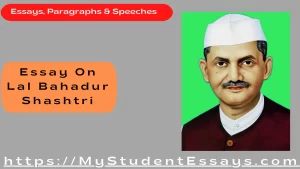Lal Bahadur Shastri was a renowned Indian Leader. His life was full of struggles, commitment, dedication and work towards the betterment of his fellowmen. This short and long Essay on Lal Bahadur Shastri, describing his early, his struggles for children and students
Essay on Lal Bahadur Shastri: Early Life, Achievements
Lal Bahadur Shastri was an Indian statesman who served as the second Prime Minister of India, from 1964 until his death in 1966. He was a leader of the Indian National Congress party and a close ally of Jawaharlal Nehru.

Shastri was born into a Brahmin family in Mughalsarai, United Provinces, British India. He joined the Indian independence movement in the 1920s. He was arrested and jailed several times by the British authorities for his involvement in the movement. After completing his primary education, he attended the Kashi Vidyapeeth and obtained his degree in philosophy from there.
>>>> Read Also: ” Essay on Sardar Vallabhbhai Patel“
Shastri joined the Indian National Congress party in the early 1930s. He served as the president of the party’s provincial branch in Uttar Pradesh. He was elected to the Lok Sabha, the lower house of India’s parliament, in 1952. Shastri became a senior leader of the Congress party and served as Minister of Railways in the cabinets of Jawaharlal Nehru and Indira Gandhi.
After the death of Jawaharlal Nehru in 1964, Shastri was elected as the second Prime Minister of India. He served as Prime Minister until his death in 1966. He is remembered for his slogan “Jai Jawan, Jai Kisan” (Hail the Soldier, Hail the Farmer), which he popularised during the Indo-Pakistani War of 1965. He also initiated the Green Revolution in India, which greatly increased food production in the country.
His Contributions
Lal Bahadur Shastri is credited with several notable achievements during his short tenure as Prime Minister. He successfully resolved the Sino-Indian border dispute through negotiations, which resulted in the signing of the Border Peace and Friendship Treaty between India and China in October 1962.
He also promoted the White Revolution – a nationwide campaign to increase milk production – which was successful in increasing milk production in the country.
In 1965, Shastri led India to victory in the Indo-Pakistani War of 1965. The war ended with the signing of the Tashkent Declaration between India and Pakistan.
Shastri also initiated the Green Revolution in India, which led to a significant increase in food production in the country.
Shastri is widely regarded as an honest and sincere politician, and is remembered for his slogan “Jai Jawan, Jai Kisan” (Hail the Soldier, Hail the Farmer). He is also considered to be one of the architects of modern India.
Death of Lal Bahdur Shahstri
Lal Bahadur Shastri died of a heart attack on 11 January 1966, barely two years after he became Prime Minister. He is buried at Vijay Ghat in New Delhi.
>>>> Read Also: ” Essay On Nelson Mandela a Great Leader “
Conclusion:
Lal Bahadur Shastri was a prominent Indian statesman who served as the second Prime Minister of India. He is remembered for his slogan “Jai Jawan, Jai Kisan” (Hail the Soldier, Hail the Farmer), and is considered to be one of the architects of modern India. Shastri died of a heart attack in 1966, and is buried at Vijay Ghat in New Delhi.
